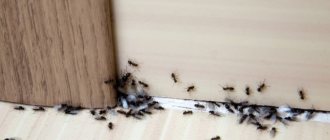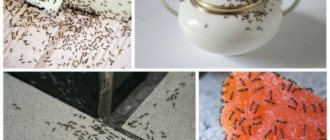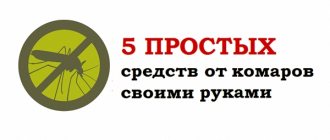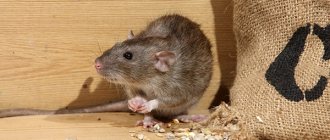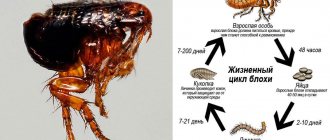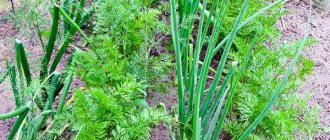03/30/2018 Category: AntsAuthor: Lara Lisina
Ants are not the most pleasant neighbors both in the house and in the garden; they have long been considered pests along with other annoying insects. To get rid of ants, people have invented many chemicals and folk methods. And one of them is the use of millet cereals. But can it be considered effective?
- 2 Why millet
- 3 How to work with millet
3.1 Dry millet
3.1.1 Video: millet against ants
How ants harm the garden
At first glance, the interests of ants and humans overlap little in the garden: humans grow vegetables and fruits, ants build anthills and feed their offspring. However, it often happens that the homes of these insects are located in beds, flower gardens and under trees, which in itself is inconvenient for gardeners. But first of all, this harms the root system of plants, especially young shoots, and ants sometimes eat ripe berries and vegetables. The main danger to the garden is aphids, which suck the juice from the stems, buds and leaves of plants.
Ants breed aphids, which are dangerous for cultivated plants.
In addition, aphid secretions are an excellent breeding ground for many pathogenic fungi, such as black sooty mildew. But it is the ants who breed these tiny pests. Thus, ants cause damage to your area both directly and indirectly.
Folk remedies for fighting ants
Ants are highly developed insects that have a complex social structure. You can admire their intelligence and hard work. However, house and garden ants are considered pests and do not evoke positive feelings. There are many modern drugs to combat insects, but many owners prefer folk remedies. They are often more accessible and cheaper, and most importantly, more environmentally friendly and safer for health.
Why millet
The very idea of fighting ants with millet may at first seem unexpected and very strange. After all, there is still no clear explanation of the mechanism of its effect. There are no authoritative scientific studies proving the harm of millet cereals to the ant organism. There are only a few different assumptions.
- Harmful to digestion. One of the simplest and most obvious versions is that millet is harmful to the digestion of ants. Namely, it is assumed that the eaten millet swells in the intestines of the insect to sizes incompatible with life and almost tears it apart. It is not very clear whether for this the ant should eat the whole millet grain or just a part, which casts doubt on the version. Some believe that semolina, which is known to swell greatly when soaked, also gives a similar effect.
- Harmful to ant passages. Another version says that ants mistake millet grains for their eggs (due to external resemblance) and carry them to the anthill. And there, under the influence of increased soil moisture, the grains swell and clog the passages. The ants can neither leave nor enter, and the queen and offspring locked inside die of hunger. Or they leave their home to build a new, more comfortable home.
- Harm to the home. Another version, which is a variation on the previous theme, suggests that the grain softened in an anthill is not dangerous at all for passages. The thing is that mold quickly and easily develops on it, which then spreads throughout the anthill. Insects cannot cope with the fungus, and they have to leave their home and create a new one.
- Harm to the psyche. There is another assumption that sounds very fantastic. Some believe that ants mistake millet grains for their eggs - but not growing ones, but dead ones. This terrifies the insects and forces them to leave their homes in search of a safer home.
How to work with millet
If you decide to try to get rid of ants using millet, then no matter how it works, you need to attract the attention of insects to it. There are several proven methods.
Dry millet
The dry mixture consists of millet cereals with powdered sugar. To create it, take 100 grams of crushed sugar or ready-made powder per half kilo of millet and mix thoroughly. The resulting mixture is sprinkled on the anthill itself, on the ground around it, on ant paths and wherever you most often saw ants.
Millet groats are scattered on those beds where ants live
Video: millet against ants
Soaked millet
You can give the cereal a sweet taste and thereby attract insects to it in another way. In heated water, stir sugar, old jam, which you don’t mind, candied honey - quite a lot so that the water becomes sickly sweet. Then the cereal is soaked in it for no longer than a quarter of an hour.
Millet is placed in a sweet solution so that it covers the grain with a reserve
The water is drained and the cereal is laid out near the ants’ habitats.
Ammonia
The pungent odor of ammonia is unpleasant to almost all living beings. But insects and animals continue to detect ammonia vapors even after they become inaudible to humans. The network claims that the method works great, but only if you use ammonia, not ordinary pharmacy drops.
The experiment was carried out with a solution, mixing 4 tbsp. l. alcohol with 1 liter of water. A spreading tree was sprayed; such plants are very difficult to treat using any other method. Effect 100%. The main thing is not to forget about your own protection - gloves, a mask, long sleeves will not hurt.
Bottom line: ammonia helps in the fight against garden ants.
Efficiency mark
Since, as mentioned above, no scientific research has confirmed the harm of millet cereals to ants, this folk remedy cannot be considered unambiguously effective. Moreover, opinions on this matter differ greatly.
Some gardeners quite seriously consider millet to be a miraculous panacea against ants and actively advise everyone to join this means of fighting insects.
I read in the magazine “My Beautiful Dacha” Nina Alekseevna Sherstnikova (73 years old) very simple advice, literally: “Do you want to get rid of ants without chemicals? Go to the grocery store and buy millet, sprinkle it on the places where the ants have settled, and they will go away on their own.” I did not find the home of my ants and poured them around the paths and trees where there were the most of them. Today I looked, almost all the ants were offended and left.
Galina Yurievna
https://www.nn.ru/community/dom/dacha/?do=read&thread=2379070&topic_id=53466532
Some, however, clarify that to achieve the desired effect, the cereal should only be dry.
For me personally, millet helps me cope with these fussy and persistent creatures. I generously sprinkle this cereal in a continuous strip around the anthill, as well as across their well-trodden paths. There is one secret: you need to do this in dry weather (and if you are pouring from your hands, then your palms should not be wet either). I don’t know what this is connected with, but for some reason ants do not react to raw millet.
Lyudmila
https://forum.osadovod.ru/threads/kak-borotsja-s-muravjami.67/#post-512
Others confirm that millet cereal can indeed help get rid of ants, but notice that after some time the insects reappear on the site. That is, the effect is exclusively temporary.
I tried to sprinkle millet, this is the effect - they leave the place where it was poured, but organize themselves nearby, where there is no millet... 1 kg of millet showed the result at first, they bought another 5 kg... but they did not sprinkle these 5 kg, as mentioned above - they moved away from him
olya14146
https://www.nn.ru/popup.php?c=classForum&m=forumCutTree&s=1484&do=cutread&thread=2379070&topic_id=53500706
And finally, there are dissatisfied people who claim that in fact millet is absolutely ineffective and ants are not afraid of it, and other people’s rave reviews are nothing more than profanation.
I tried it. My ants don't care about millet. I have the impression that the entire anthill was giggling at me.
Taniatravinckina
https://sazhaemsad.ru/forum/kak-izbavitsya-ot-muravev-v-cvetnikah-i-na-gryadkah-t456–10.html#p10754
Many such gardeners are sure that millet cannot compete with chemical insecticides.
Millet didn’t work on mine either; nothing works on them at all. They only leave the “Great Warrior,” but not for long...
Fisherka
https://forum.prihoz.ru/viewtopic.php?p=759314&sid=13d32a458a669ec23ec98e0730080490#p759314
It is quite possible that the effectiveness of millet cereals in a particular garden plot depends on some unknown external factors. In addition, it remains unclear which millet varieties are suitable for baiting insects. So it’s still not worth recommending it as a universal remedy for ants.
Ready baits
Among gardeners, the composition of Ant is legendary. The mixture literally kills insects on the spot and in any quantity. For the sake of the experiment, a nest of black ants was chosen, which love to settle deep underground and mercilessly spoil the beds.
According to the instructions, the Ant is poured into a stirred up anthill. Sprinkle the top of the pile with soil and wait a day. The next day there will be no trace of the ants left. As a result, the drug worked 100%.
The advantage of using Ant is that you don’t need to mix, spray or water anything. It is enough to remove the top of the pile, pour in the powder and give it a little time.
The owner decides which method to choose. You can combine methods - spray the trees with ammonia solution, use boiling water with or without vinegar on the paths, protect the beds with Ant.
Another option is to buy an insect repeller. An ultrasonic device generates signals that are inaudible to humans, but extremely unpleasant for all insects. To learn more about ultrasonic repeller, call our company. An experienced manager will tell you what to do and how to get rid of garden ants if they have infested your area.
Is this folk method of getting rid of ants dangerous?
Both supporters and opponents of millet cereals agree that if it is dangerous, it is only for ants. Since no chemical additives are added to millet - only sugar - it itself is absolutely safe for both people and animals. The only exceptions are those pets who have an individual intolerance to millet, digestive diseases, or are forced to follow a low-carbohydrate diet. If your pet belongs to one of these categories, you should place the millet in places inaccessible to it.
However, unwashed millet is harmful for birds: it negatively affects their digestion due to the toxins and oxidation products that accumulate in it. If you keep a bird in a country house that has access to the area, it is better to refrain from using millet against ants. The same applies to poultry: you should either give up millet or not let your feathered pet out of the cage while the fight against ants is going on.
Shag or tobacco dust
Both are well-known assistants in pest control. Decoctions and infusions of tobacco dust remove mole crickets; dry scattered shag will repel whiteflies from cabbage. A powerful remedy is used in the form of decoctions and infusions. They fill the passages, the inside of the heap and simply spray it over the surface of the “dwelling” of insects.
You can do it easier - remove the top of the pile, add tobacco dust and wait. That's exactly what was done. After about an hour and a half, the ants had almost cleared their house of insecticide, simultaneously restoring the damaged top.
Conclusion: without additional measures, tobacco dust is not effective.
What can you take instead of millet?
In addition to millet, supporters of folk remedies often suggest using other food products against ants.
- It is proposed to use semolina in the same way as millet - sweeten it and place it in places where ants are active. It is assumed that it will also greatly swell in the insect’s stomach and it will die from indigestion. To cause intestinal problems in ants, soda and yeast mixed with powdered sugar are also used.
- Unrefined sunflower oil, garlic and lemon are not liked by ants because of their pungent odors; they are believed to repel insects. Garlic cloves and lemon peels are placed in those places that need to be rid of ants. Oil is used to lubricate ant paths, as well as dishes and furniture that need to be protected from parasites.
- Black pepper, red hot pepper, mustard powder and cinnamon are scattered along the ant paths. Supposedly, these spices are unpleasant due to their strong odors, as well as their ability to cause digestive irritation.
- Coffee grounds are also sometimes considered an ant repellent. It is most often used in the garden to protect flower beds, berry beds and fruit trees. Dried, sleeping coffee is scattered on the beds and around the trunks.
Basic methods of struggle
It is quite difficult to completely get rid of yellow ants. Destruction of insects through mechanical action will not bring any benefit - after a day there will be even more parasites, since the founder of the entire colony is the queen. It is she who must be destroyed in order to achieve victory.
If there is no access to the nest where the queen is located, you must try to poison her. For this purpose, it is recommended to use the following remedies for yellow ants in your apartment:
- bait;
- chemicals (aerosols, powders, gels);
- folk methods.
The chemical composition includes cypermethrin, diazinon, deltamethrin. These substances have a detrimental effect on parasites.
Boric acid
Boric acid is considered an effective method of controlling yellow pests. The advantages of this remedy lie in the following action: when the substance enters the body of an ant, it corrodes the walls of its intestines, leads to dehydration of the body, and provokes disruption of the central nervous system. This reaction leads the insect to paralysis and further death.
Preparations based on this product also have a sterilizing effect, which applies to both females and individuals of the opposite sex. Thanks to their complex action, these factors make it possible to destroy an insect colony.
You can make food bait at home using boric acid. The technology for its preparation is simple:
- Grind the boiled chicken yolk and eggs.
- Combine with unrefined sunflower oil and honey.
- Add 10 g of boric acid.
- Form balls from the mass and place them in places where insects gather.
With minced meat
An effective remedy based on this chemical can be prepared with meat. The composition of the bait is as follows:
- Combine 3 tbsp. l. minced meat with 1 tsp. main ingredient.
- Form small peas.
- Place the balls along the path of the parasites.
Honey and jam
Yellow ants love sweets very much
To attract their attention with a new bait, it is recommended to prepare the product with 2 tsp.
thick jam or honey, add 3 tsp to the product. sugar and 0.5 tsp. boric acid.
Yeast
You can use the sweet filling in a different way. For the recipe you will need: 1 part each of jam, boric acid, yeast and 2 times more water. Heat the water and dissolve the yeast, add the remaining ingredients. Mix the mixture thoroughly, then pour the liquid in a thin layer onto a saucer. Place traps in different rooms.
Borax
Poisonous bait with borax will help cope with the problem. You need to mix boric acid, glycerin and water in proportions 1:4:2. Add any sweetness (honey, sugar, jam) to the contents and heat the product over low heat. The result should be a homogeneous consistency. Spread the poison in places where yellow parasites accumulate.
Poison traps
Ant traps in the house are the safest way to get rid of insects quickly. These devices have a number of advantages:
- high efficiency;
- ease of use;
- long lasting result;
- safety for living beings;
- low price.
The most popular trap options are:
- Raptor;
- Raid;
- Battalion commander
Raptor
It is necessary to determine the location of the nest or the route of movement of parasites, and treat corners and crevices. Perform the treatment procedure once every 3 days. The duration of exposure depends on the number of insects and continues until they disappear completely. The cost of the trap is from 200 rubles.
Raid
Raid devices are ready-made bait that should be placed in places where insects are located. The composition contains substances that attract colony scouts. They eat the poison and become its distributors. The chain reaction lasts until the colony is completely destroyed.
The poison acts gradually, over 1.5 days. This period of time is enough for the ants to return to the nest and spread the toxic substance to healthy relatives. To ensure destruction, the procedure must be repeated (a few days later). The cost of a trap starts from 160 rubles.
Combat
The ant trap contains the insecticide hydramethylnon. Discs with bait must be secured to wall and floor surfaces (horizontal or vertical). Results can be expected 4 weeks after starting to use the trap. The product is recommended for use in the home and garden. The cost of one trap is 150 rubles.

